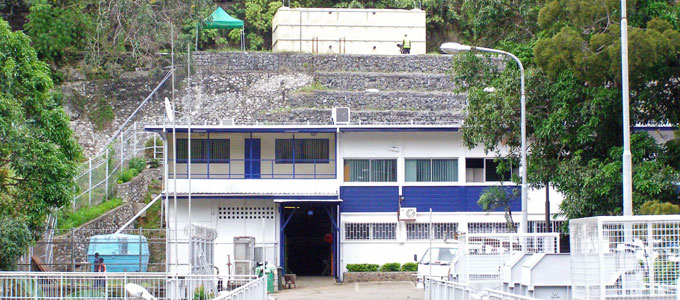THOUGHT LEADERSHIP
Prioritising safety at Rouna 2 hydropower station, PNG
As the saying goes, ‘safety doesn’t happen by accident’.
The measures taken to address safety risks at the underground Rouna 2 hydropower station in Papua New Guinea offer a timely reminder of the basic requirements for adequately managing safety risks and protecting workers when upgrading older hydropower stations or when developing new ones.
The upgrade of Rouna 2 – including adequate exits, flood protection, fire and smoke detection and control, and emergency management – illustrates that much more than just the main generating equipment needs attention to adequately identify and address safety risks and hazards in a hydropower station.

A run-down, risky hydropower station
Rouna 2 is one of four stations operating in a cascade down the Laloki River. It has five 6 MW vertical-axis hydro units from the late 1960s housed in an underground machine hall. Although only a small station, Rouna 2 has all the complexity and requirements of a much larger station.
By the time specialist power and water consulting firm Entura began working on the project to upgrade Rouna 2, the power station was old, run down by years of hard work, and was presenting its owners and workers with safety risks typical of many older hydropower stations.
The initial project concept was simply to refurbish the machines, but it quickly became clear that repairing or replacing only the generating units wasn’t going to be enough to sustain the power station’s operation, and that safety concerns needed to be urgently remedied.
Upgrading station evacuation
The Rouna 2 power station originally had only one access and exit route for the underground machine hall via open stairs in a 200 metre-deep vertical access shaft. No alternative emergency exit route was available. As the access shaft also contained all the power and control cables, it further intensified fire and safety risks.
To improve evacuation, a new emergency escape route was created via new ladders and platforms down the tailrace surge shaft to the tailrace tunnel, which normally carries water out of the power station.
Within the machine hall, the emergency escape route was made safer by being enclosed and made fire resistant, and kept smoke-free by a fan started automatically. Smoke hoods (emergency evacuation masks that reduce the risks of inhaling toxic smoke and gas) are provided to offer temporary protection for personnel needing to cover large distances to the start of the safe escape route.
To provide adequate lighting and signage for emergency escape, the DC-powered emergency lighting was upgraded. Evacuation alarms were improved, including strobe lights as well as audible sirens.
Improving flood protection
An underground power station surrounded by huge quantities of water under high pressure is particularly vulnerable to flooding. Rouna 2 had poor flood protection and dysfunctional evacuation alarm systems.
The evacuation alarms were upgraded and linked to flood detection within the machine hall. An automatic flood protection scheme was implemented to shut down the underground generating units and close the surface intake gate.
Improving fire and smoke detection and control
Hydropower stations are at risk of fire because they are full of electrical equipment. The Rouna 2 station had no fire detection system and minimal fire protection systems, so urgent attention to all fire measures was needed.
New fire panels and a new fire detection system were installed, as well as a new fire-fighting water supply, fire hydrants and hose reels. Sprinklers were installed in the access shaft and the machine hall. Older carbon-dioxide-based fire-protection systems for generator fires were replaced with water-spray systems. Fire doors were rehabilitated to close automatically.
Implementing an innovative new ventilation system
Ventilation systems in hydropower stations seldom provide any adequate smoke removal, despite the dangers of smoke inhalation. Technical innovations in the upgrade of Rouna 2’s safety systems included methods for smoke control integrated with the station’s ventilation system and its new fire panels and doors.
We upgraded the ventilation and smoke exhaust system by automatically reversing the ventilation fans during a fire, so that they exhaust smoke from the machine hall to the surface, and draw fresh air back down into the machine hall. At the same time, automatic fire doors close within the machine hall.
A safer power station for a safer future
Although new, large hydropower developments typically embrace complex and comprehensive safety standards and features, around the world many older stations are seriously deficient, presenting hazards that urgently need to be identified and resolved. Through our improvements to its ancillary services and safety systems, Rouna 2 is no longer in this extreme risk category.
However, adequate safety facilities are not the only requirement to maintain a safe hydropower station. Workers need the knowledge to maintain safety features, equipment and systems, and the skills to use them effectively. Entura has provided contract operators and station managers to work alongside local employees to help improve emergency and crisis management systems, provide local training and build capacity to ensure that Rouna 2’s future promotes a safer power station and safer workers.
To discuss how Entura can assist you with assessing hydropower station risks or developing a hydropower safety program or upgrade, please contact Ambrose Canning on +61 3 6245 4212 or Shekhar Prince on +61 412 402 110.
About the author
Ambrose Canning is Entura’s Principal Consultant, Mechanical Engineering. He has more than 30 years’ experience working on hydropower and water infrastructure projects in Australia, New Zealand, Malaysia, Papua New Guinea, India, Nepal, Philippines and Indonesia. He specialises in all aspects of hydropower development and redevelopment, upgrade and rehabilitation. He also has expertise in aspects of water infrastructure, such as dam electro-mechanical and hydro-mechanical equipment, pipelines, valves, pumps, screens, gates, valves and bulkheads.
MORE THOUGHT LEADERSHIP ARTICLES
November 5, 2015






